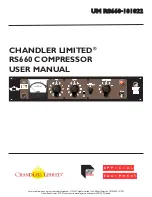
10
RS660-101022
Meter Adjustment
Vacuum tube compressors and limiters require warm-up
time for proper adjustment and optimal performance. The
suggested warm-up time prior to any adjustments or use is
ten minutes.
Once the RS660 Compressor has completed the warm-up
cycle, the engineer may make fine adjustment of the gain re-
duction meter’s needle. By means of the
Zero Adjust (ZA)
screw located on the meter face, and using a small flathead
screwdriver, the recording engineer may place the
needle
for
— or near — [0] on the indication range.
Warning:
The ZA screw adjustment range is finite or narrow
in scope. Over adjustment of the ZA screw may damage the
gain reduction meter.
Note:
The majority of vintage tube compressors and limit-
ers are unregulated circuits and are subject to environmental
power conditions. Therefore, it isn’t uncommon for a gain
reduction meter needle to sit higher than zero in some re-
cording studios and fall beyond the range of the meter’s ZA
utility.
Reading the meter
The gain reduction meter allows the engineer to observe the
amount of compression imparted on the original source ma-
terial. The the indication range is labeled in
decibels
(dB)
—
right to left — from 0 to 30.
The gain reduction meter needle deflects to the left and
serves to guide the recording engineer to a value. Higher val-
ues on the gain reduction meter indication range represent
more compression.
The rate of movement of the gain reduction meter needle —
although much slower than the speed of electrons — roughly
indicates compressor/limiter reactivity to the source signal.
Time Constant
The
TIME CONSTANT
switch is used to set the reactivity or
response time of the RS660 Compressor, and features seven
positions.
The seven TIME CONSTANT positions are labeled [1-7],
with position one being fastest and seven slowest.
Positions 1-3 are fast and meant to replicate the faster — and
most liked — settings of the Fairchild 660. These first three
settings produce a colored and vintage tone.
Position four is moderate, a bridge between the faster and
slower settings; this setting is excellent for less colored vocals
and guitars.
Positions 5-7 are purposedly quite slow and influenced by
the gentle, uncolored and low artifact compression of many
vintage valve compressors, including the EMI RS124.
Tip:
The slower settings are able to yield large amounts of
compression with little observable artifacts of compression.
By contrast, the faster settings are the polar opposite and ca-
pable of being more audibly colored and vintage in character.
Metering
Provision has been made for monitoring of the processed
signal by means of an analog
gain reduction
meter.
T I M E C O N S T A N T
P O W E R
4
3
2
I
6
7
5
T H D
C O M P
L I M I T
L I N K
4
3
2
I
0
6
7
8
9
5
I0
®
I N P U T
dB
COMPRESSION
30
0
20
15 10 5

































